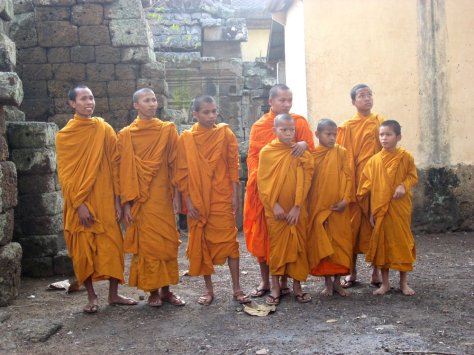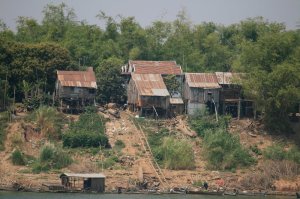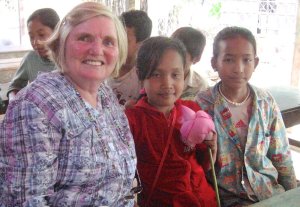Cambodia to Vietnam – lands of contrasts but where religions co-exist with no prejudice – young boys of all religions can be sent to the Buddhist monks to be taught basic skills and they can choose to remain as monks or leave when their family requires them for rice harvest, or they feel sufficiently educated or old enough to return to their villages to take up normal occupations.

Day 1
Having arrived on board “The Jayavarman” on the Saturday afternoon, we were greeted with a welcome drink and a buffet lunch. Before we departed a group of local children came on board to show us how they perform the Cambodian dance. As well as about a dozen dancers aged between five and twelve, they entertained us with music – two of the older girls playing the zither and xylophone and three boys on drums. All a delight to watch, especially the little ones aged about five who already had the beautiful hand movements that these East Asian cultures are famous for.
After setting sail, we had our first real experiences of what Cambodian life on the river is all about, passing many types of buildings, from temples to rickety houses set high on the river bank to avoid flooding during the yearly wet season
Crafts of all descriptions were to be seen, from the lowly sampan to the ‘commercial’ fishing barge
Later that day our first excursion was to visit the Wat Nokor, a colourful monastery built within the ruins of a 12th century Angkorian-era temple.
Then onto see the Bamboo Bridge – a local wonder that gets rebuilt whenever it is washed away by the monsoon rains. We had to have a walk, or ‘bounce’ would be a more appropriate term, onto it and as we manoeuvred our way over the bamboo fronds to start our crossing, it was only to find some motor vehicles heading towards us from the other side of the bridge. We made a hasty retreat.
After lunch we motored further south on the river to a typical small village where we viewed the local crop of row upon row of small red chillies, the peanuts having already been harvested; we wandered around the houses built on stilts for coolness and to avoid any flooding and where they keep their cows; we were invited into the local school to interact with the children who were so eager to speak to us in English; each one saying by rote
“Hello, how-do-you-do, my name is —– and I want to be ….. a doctor, guide, football player, president !”
They are all very ambitious and desperately wish to be educated – they asked us questions
What is your job?
Do you have brothers and sisters? How old are you? Do you have children?
The little girl I was talking to presented me with the lovely pink lotus flower that you see her holding.
Village life is so very different to ours – washing dishes in rainwater by the side of the village path, drying and packing the latest crop of peanuts
Every day, bar one when we motored for a whole day without stopping, we were usually taken for two excursions ashore.
Day Two
Breakfasts were a buffet affair- for the English there was bacon, tomato, mushrooms, baked beans, hash browns etc., – for the Europeans, cheese, meat, gherkins, bread and pastries, as well as cereals and of course lots of fresh fruit, and juices, all beautifully prepared.
There were also two cooking stations one on each side of the buffet – one station prepared pancakes and eggs in whatever style was required – omelettes scrambled, fried, poached whilst the other station prepared a Cambodian breakfast of soup. For this, the chef would take a small fine mesh sieve into which he would drop some thin rice noodles, as well as a few bamboo shoots, onion, some finely chopped green leaf vegetable like pak choy or spinach and if you fancied it, either some slithers of meat or fish – the whole sieve would then be suspended in boiling water and cooked for a few minutes before being turned out into a bowl whereupon a ladle of chicken broth would be poured over the top and small amounts of chilli or ginger and a squeeze of lime added – all to your own particular taste, and the dish was finished. This is what I had on a daily basis as it was so fresh and one didn’t feel ‘weighed down’ with a European repast. Out of the 50 passengers, I think only one other gentleman on the boat ever joined me in a Cambodian breakfast and it wasn’t my husband!
We visited the ancient temple complex of Wat Hanchey overlooking the river with breath-taking views but with 291 steps to climb to the top. It was also possible to make the journey on the back of a motor scooter for 1.00 US$ which is what half a dozen of us did – my scooter taxi driver was a young lady who drew the lucky number from a score or so to have me perched up behind her as we motored round the dry red dusty road to the top of the hill whilst the rest of the group clambered up to the top unaided.

With all of these temple complexes there is a total mix of Buddhist and Hindu with statues, paintings and images of Buddha as well as various gods.
Considering how poor the village people are, these complexes are always well painted and resourced with hostels for visitors, kitchens, dining rooms and facilities for the monks, all paid for by donation. Those who give significant amounts can have their names inscribed on plaques for all to see how generous they have been.
The children would accompany these strange Western tourists everywhere, not to beg, but to try and talk to us in English, or as one young girl told us, she wanted to listen to our guide, for she wished to be a guide once she had finished school.
Then it was time to descend the 291 steps back to the boat. The traditional serpents writhing their way down each side of the balustrade to rear their multiple heads at the bottom.
So back to the luxury of our cabins complete with en-suite bathrooms, beautifully prepared and presented food but we were returning with the lasting impression that the Cambodian people always have a smile on their face and a cheerful nod of recognition and a desire to be educated.

























You must be logged in to post a comment.